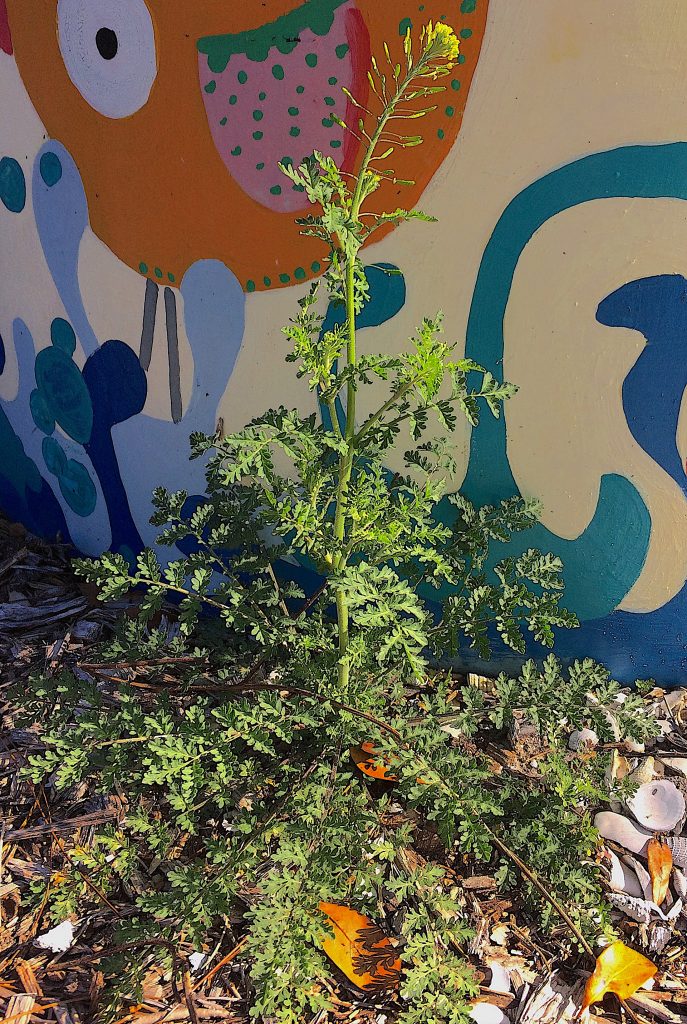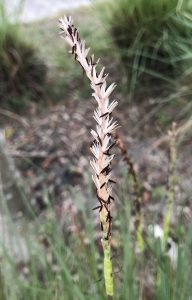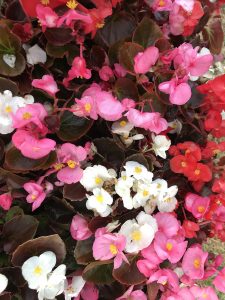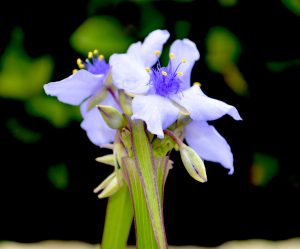
Wester Tansy Mustard is an over overlooked wild edible. Photo by Green Deane
The Western Tansy Mustard is one of our shortest-lived wintertime forageables. It’s not flashy and is often either too small or too old to be seen. It also likes very dry places and cool temperatures. I often find it dusty areas where you find livestock such as paddocks and corrals. Of all the micro-mustards it is the mildest in flavor, at least for humans. The texture is fuzzy. More confusing is there is no Eastern Tansy Mustard. You read about the Western Tansy Mustard here.

Eastern Gamagrass is starting to blossom. Photo by Green Deane
Grass and ice cream are usually not considered at the same thought unless it is Eastern Gamagrass. Why? Because livestock like the clumping Tripsacinae so much cattlemen call in Ice Cream Grass. While it can be used like wheat it’s a distant relative of corn and can be popped. Eastern Gamagrass, also called Fakahatchee Grass, is sod-forming and can reach up to eight-feet tall. Though it is pollinating and seeding now the grass can seed from now to September. The frilly male flowers occupy the top three-fourths of the seed spike and the stringy female flowers the bottom fourth. In this species the ladies are brown, hair-like structures. Besides fodder Eastern Gamagrass is also a common ornamental found in parks and residential areas. A bunch can live to be 50-years old or more. Fakahatchee, by the way, means either Forked River or Muddy River. Opinions vary. To read more about Eastern Gamagrass go here.

Begonias’ flavor varies with color and growing medium. Photo by Green Deane
This might be a good time to mention that Begonias are edible. We saw some this weekend at my foraging class. Unfortunately a rather popular book some 30 years ago said they are not edible. I actually spoke with the author once and she told me in subsequent editions that mistake would be changed but the book never went into second edition. Thus the mistake can be found on the internet. Begonias are not only the favorite of growers (and cemetery pots) they are naturalized locally. I see them often in damp spots such as stream banks or drainage ditches. The leaves are edible as well as the blossoms. They can be prepared in a variety of ways and the juice is also a vegetarian rennet. My favorite are wax begonias (and the flavor can vary with their color.) You can read about them here.

Classes are held rain or shine or cold.
Spanning two coasts this weekend with a foraging class in Largo, Florida, at Eagle Lake Park, and one in Port Orange just south of Daytona Beach at Spruce Creek Park. Dress for chilly weather. Though cool there’s plenty of plants to see.
Saturday, January 16th, Eagle Park Lake, 1800 Keene Road, Largo, FL 33771. 9 a.m. to noon. Meet at the dog park pavilion.
Sunday, January 17th, Spruce Creek, 6250 Ridgewood Ave. Port Orange, 32127. 9 a.m. to noon. Meet that the pavilion (first right after house.)
Saturday, January 23th, Blanchard Park, 10501 Jay Blanchard Trail, Orlando, FL 32817. 9 a.m. to noon, meet at the pavilion by the tennis courts.
Sunday, January 24th, Red Bug Slough Preserve, 5200 Beneva Road, Sarasota, FL, 34233. 9 a.m. to noon.
Saturday January 30th, Wickham Park: 2500 Parkway Drive, Melbourne, FL, 9 a.m. to noon. Meet at the dog park.
Sunday January 31st, Bayshore Live Oak Park, Bayshore Drive. Port Charlotte. 9 a.m. to noon, meet in the parking lot at Ganyard and Bayshore.
Saturday February 6th, Boulware Springs Park, 3420 SE 15th St., Gainesville, FL 32641. 9 a.m. to noon, meet at the pavilion by the pump house.
Sunday, February 7th, Mead Gardens, 1500 S. Denning Dr., Winter Park, FL 32789. 9 a.m. to noon. The entrance is on the west side off Denning not the east side off Pennsylvania. Some GPS maps are wrong. Meet near the bathrooms.
For more information, to pre-pay or sign up go here.

Spiderwort blossoms can be blue, white or ruby. Photo by Green Deane
Spiderworts got me in trouble once. I let them cover my entire lawn in suburbia. That prompted a visit from Lawn Enforcement Officers. I was cited in writing for having an unkept lawn which meant covered with weeds (that they were pretty, native “weeds” was deemed irrelevant.) As I thought the citation wrong I read the pertinent law. It said a weed was a plant unintentionally over 18 inches high. Problem solved. My spiderworts were intentionally over 18-inches high. I watered and fertilized them. Consequently I beat the rap. And while Spiderworts favor the spring you can find them blossoming now here and there. Spiderworts are quite edible, at least all the parts above ground. They can be consumed raw, cooked or fermented. While this is not too descriptive they taste “green” to me, not distinctive but pleasant. Spiderworts have a history, by the way, being connected to John Smith of Pocahontas fame. You can read about them here.

Green Deane videos are now available on a USB.
150-video USB or 135 video DVD set would be a good winter present and either is now $99. My nine-DVD set of 135 videos has been selling for seven years and are still available. They are the same videos I have on You Tube. Some people like to have a separate copy. A second option is a16-gig USB that has those 135 videos plus 15 more. While the videos can be run from the DVDs the videos on the USB have to be copied to your computer to play. They are MP4 files. The150-video USB is $99 and the 135-video DVD set is now $99. The DVDs will be sold until they run out then will be exclusively replaced by the USB. This is a change I’ve been trying to make for several years. So if you have been wanting the 135-video DVD set order it now as the price is reduced and the supply limited. Or you can order the USB. My headache is getting my WordPress Order page changed to reflect these changes. We’ve been working on it for several months. However, if you want to order now either the USB or the DVD set make a $99 “donation” using the link at the bottom of this page or here. That order form provides me with your address, the amount — $99 — tells me it is not a donation and in the note say if you want the DVD set or the USB.

Green Deane Forum
Want to identify a plant? Perhaps you’re looking for a foraging reference? You might have a UFO, an Unidentified Flowering Object, you want identified. On the Green Deane Forum we — including Green Deane and others from around the world — chat about foraging all year. And it’s not just about warm-weather plants or just North American flora. Many nations share common weeds so there’s a lot to talk. There’s also more than weeds. The reference section has information for foraging around the world. There are also articles on food preservation, and forgotten skills from making bows to fermenting food.
This is weekly newsletter #440. If you want to subscribe to this free newsletter you can find the sign-up form in the menu at the top of the page.
To donate to the Green Deane Newsletter click here.

